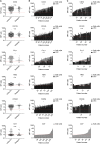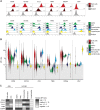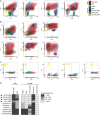Coexpression profile of leukemic stem cell markers for combinatorial targeted therapy in AML
- PMID: 29946192
- PMCID: PMC6326956
- DOI: 10.1038/s41375-018-0180-3
Coexpression profile of leukemic stem cell markers for combinatorial targeted therapy in AML
Abstract
Targeted immunotherapy in acute myeloid leukemia (AML) is challenged by the lack of AML-specific target antigens and clonal heterogeneity, leading to unwanted on-target off-leukemia toxicity and risk of relapse from minor clones. We hypothesize that combinatorial targeting of AML cells can enhance therapeutic efficacy without increasing toxicity. To identify target antigen combinations specific for AML and leukemic stem cells, we generated a detailed protein expression profile based on flow cytometry of primary AML (n = 356) and normal bone marrow samples (n = 34), and a recently reported integrated normal tissue proteomic data set. We analyzed antigen expression levels of CD33, CD123, CLL1, TIM3, CD244 and CD7 on AML bulk and leukemic stem cells at initial diagnosis (n = 302) and relapse (n = 54). CD33, CD123, CLL1, TIM3 and CD244 were ubiquitously expressed on AML bulk cells at initial diagnosis and relapse, irrespective of genetic characteristics. For each analyzed target, we found additional expression in different populations of normal hematopoiesis. Analyzing the coexpression of our six targets in all dual combinations (n = 15), we found CD33/TIM3 and CLL1/TIM3 to be highly positive in AML compared with normal hematopoiesis and non-hematopoietic tissues. Our findings indicate that combinatorial targeting of CD33/TIM3 or CLL1/TIM3 may enhance therapeutic efficacy without aggravating toxicity in immunotherapy of AML.
Conflict of interest statement
The authors declare that they have no conflict of interest.
Figures




References
Publication types
MeSH terms
Substances
LinkOut - more resources
Full Text Sources
Other Literature Sources
Medical
Research Materials

